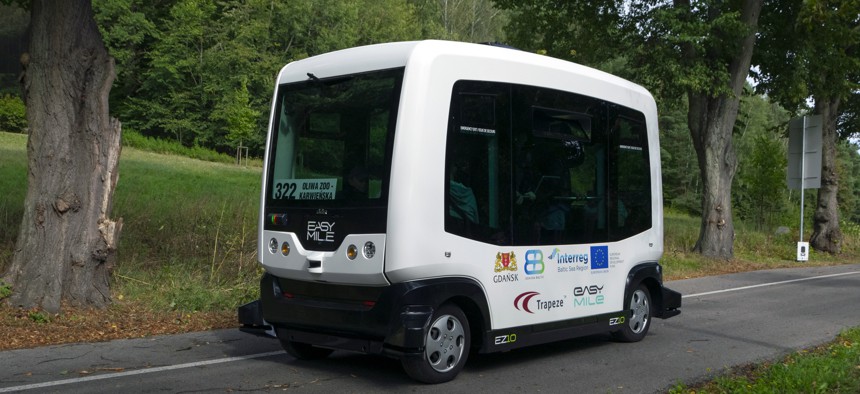AV shuttles drive wider transit options

GettyImages/Tramino
Autonomous shuttles give cities a low-risk way to test connected infrastructure, expand transit options and reduce traffic congestion.
Cities are building out their transit ecosystems to support autonomous vehicle (AV) shuttles, which offer a low-risk way to experiment with connected infrastructure and self-driving vehicles while bridging transportation inequities and improving road safety.
In Peachtree Corners, Ga., home to the Curiosity Lab, one of the country’s first 5G-enabled smart cities, officials introduced four self-driving shuttles in October 2021. Manufactured by Navya and managed by autonomous mobility company Beep, the driverless shuttles transport passengers between city hall and seven other stops along a three-mile AV test track, City Manager Brian Johnson said.
This month, the city announced plans to introduce 5G two-way cellular-vehicle-to-everything technology that will enable communication between connected traffic signals, smart street lights and vehicles equipped with on-board units, including the four AV shuttles. Residents with smartphones and tablets can also connect to the traffic infrastructure through the Travel Safely app from Applied Information.
Many cities have experimented with AV shuttles. Las Vegas introduced the first fully electric autonomous shuttle on public streets in 2017. The shuttles, which used cameras, GPS, and Lidar sensors to aid in navigation, followed a regular route through city traffic during the annual Consumer Electronics Show.
In February 2020, Columbus, Ohio, winner of the U.S. Department of Transportation’s 2016 Smart City Challenge, launched what it called “the nation's first daily-operating public self-driving shuttle” in a residential area. The city deployed two EasyMile driverless shuttles in Columbus’ Linden neighborhood, a food-insecure area to give residents access to a grocery store, jobs, services and community centers.
More recently, New Jersey Gov. Phil Murphy announced plans to deploy 100 self-driving electric shuttles to serve the state capital’s 90,000 residents. The Trenton Mobility & Opportunity: Vehicles Equity System Project will cater to the 70% of households that do not have access to a car and have limited public transportation options.
In March, Florida’s Jacksonville Transportation Authority commenced the first phase of its Ultimate Urban Circulator project. First announced in 2017, the project will eventually connect the city’s downtown area to neighboring communities with a variety of mobility options. The city chose Beep to run shuttles on a three-mile stretch of the downtown Bay Street Innovation Corridor. During the height of the pandemic, JTA and Beep experimented with a fleet of AVs to support COVID-19 testing efforts, delivering over 30,000 samples from a drive-thru testing facility to Mayo Clinic’s labs for evaluation.
Self-driving shuttles have also seen success on urban college campuses. May Mobility provided over 28,000 trips to residents, university students and visitors around downtown and the University of Texas at Arlington campus. The University of Michigan partnered with the city of Ann Arbor in a similar initiative.
“Vehicles are now overtaking smartphones as the most connected platform on the planet, just with the amount of data that is available,” Johnson said. “The next step is being able to harness it effectively.”
NEXT STORY: Can chatrooms replace courtrooms?





